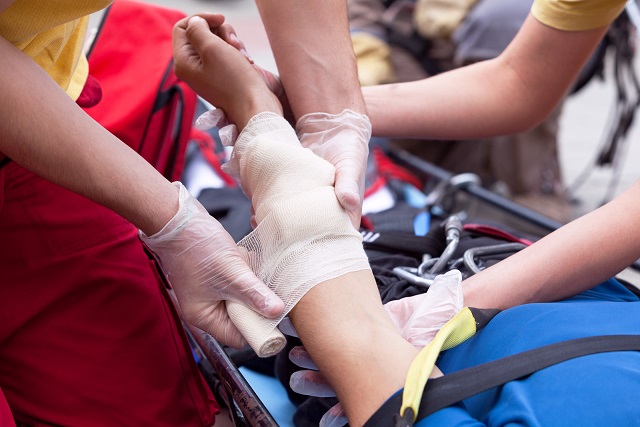Introduction
In our busy world, emergency situations can strike without caution. Whether it's a small injury, a medical emergency, or a deadly situation, knowing how to offer emergency treatment can make all the difference. This is where a First Help course enters play. Many people might wonder what they can gain from such training, and this post intends to clarify that.
By joining in a First Aid and mouth-to-mouth resuscitation course, you do not just discover bandaging injuries or performing CPR; you equip yourself with vital abilities that might save lives. So, exactly what will you discover in a comprehensive course? Allow's study the details.
First Aid Essentials: What You'll Discover in a Detailed Course
Understanding Initial Aid
What is Very first Aid?
First aid refers to the preliminary aid given to somebody suffering from an injury or illness until specialist clinical help shows up. It includes different methods and skills varying from straightforward wound like lifesaving techniques like CPR (Cardiopulmonary Resuscitation).
Importance of Emergency treatment Training
Why Needs to You Take an Emergency Treatment Course?
Taking a First Help course is necessary for numerous factors:
- Confidence: Knowing how to react in emergency situations can impart confidence. Life-Saving Abilities: The capability to carry out CPR or assist with choking can conserve lives. Career Improvement: Many occupations require certification in initial aid. Community Obligation: Learning means you can aid others effectively.
Overview of CPR
What is CPR?
CPR, or Cardiopulmonary Resuscitation, is an emergency procedure carried out when somebody's heart beat or breathing has quit. It integrates breast compressions with rescue breaths to maintain blood flow and oxygenation up until specialist assistance arrives.
The Framework of a Comprehensive Emergency Treatment Course
What Does a First Aid Course Include?
An all-around First Help and mouth-to-mouth resuscitation course usually covers the following subjects:
Introduction to First Aid Legal and Moral Considerations Scene Safety Basic Life Assistance (BLS) CPR Techniques Choking Relief Wound Care Management Burn Treatment Managing Shock Recognizing Medical Emergencies Using an Automated External Defibrillator (AED)Legal Facets of First Aid
Are There Legal Effects Associated With Offering First Aid?
Yes, giving emergency treatment does carry lawful duties called "Good Samaritan legislations." These regulations shield people who aid others in emergency situations, offered their actions are affordable and not reckless.
Scene Safety and security: The First Step
How Do You Guarantee Scene Safety?
Ensuring scene safety and security entails evaluating the environment before coming close to the sufferer:
- Look for prospective risks (website traffic, fire). Make certain it's risk-free for both you and the victim.
Basic Life Support (BLS)
What Role Does BLS Play in Emergency Situations?
Basic Life Support consists of the basics of maintaining life functions till additional clinical help arrives. This section covers vital skills such as:
- Checking responsiveness Activating emergency services Performing high-grade upper body compressions
Advanced mouth-to-mouth resuscitation Techniques
What Are Advanced Techniques Covered in Mouth-to-mouth Resuscitation Courses?
Advanced strategies might include:
- Two-rescuer CPR Use of obstacle tools for rescue breaths Special factors to consider for babies and children
Choking Alleviation Techniques
How Do You Aid A Person Who is Choking?
Choking alleviation entails 2 vital techniques:
The Heimlich maneuver for adults. Back strikes and upper body thrusts for infants.Wound Care Management
How Do You Correctly Take Care Of Wounds?


Effective wound administration involves:
- Cleaning the wound with saline or tidy water. Applying antibiotic ointment. Covering it with sterilized dressings.
Burn Treatment
What Are Effective Approaches for Treating Burns?
Burn treatment varies by degree:
Cool the burn under running water. Cover it with non-stick dressings. Seek medical interest for serious cases.Managing Shock
How Is Shock Recognized and Treated?
Recognizing shock includes searching for symptoms like pale skin, quick pulse, or confusion:
Lay the person down. Elevate their legs unless there are injuries protecting against this. Keep them calm until aid arrives.Recognizing Clinical Emergencies
What Sorts of Medical Emergencies Need To You Realize Of?

Common clinical emergency situations Hop over to this website consist of:
- Heart strikes Stroke Severe allergic reactions Understanding these problems aids you act quickly.
Using an Automated External Defibrillator (AED)
How Do You Make use of an AED Correctly?
Using an AED involves turning it on, connecting pads according to illustrations on the device, and adhering to voice prompts carefully.
Importance of Continuous Learning
Why Is Continual Knowing Important in First Aid Training?
Continuous understanding ensures you remain upgraded on best methods and new protocols in emergency treatment care.
FAQs About First Aid Courses
What Is Consisted of in a Requirement Emergency Treatment Course?- A conventional training course commonly covers standard life assistance, injury monitoring, choking alleviation techniques, and lawful considerations.
- Most training courses range from 6 hours to 16 hours relying on the depth of material covered.
- Yes, upon effective completion of most training courses, individuals obtain a first help certificate, which is usually legitimate for two years.
- Yes! Many companies supply on the internet courses that supply adaptable understanding atmospheres while still being effective.
- Absolutely! Hands-on technique is critical for mastering skills like breast compressions and making use of AEDs effectively.
- Generally, there are no age restrictions; nevertheless, participants have to be emotionally skilled to learn these life-saving skills effectively.
Conclusion
Enrolling in a thorough emergency treatment course furnishes people with crucial understanding that can save lives during emergencies-- whether in your home, work, or out in public rooms! From understanding fundamental life assistance procedures like CPR to learning just how to manage wounds correctly or acknowledge indicators of shock-- these programs supply indispensable training that anyone can profit from!
As we navigate via our every day lives loaded with unpredictability-- what much better method than preparing ourselves via knowledge obtained from structured training sessions concentrated on conserving lives?
In conclusion-- if you're pondering taking up any type of kind of first-aid training-- never ever be reluctant! Equip on your own today with these effective tools due to the fact that readiness really makes all the distinction when every 2nd counts!